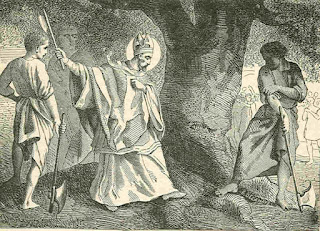Preferably, a knighting was planned ahead for a feast day, which would bring more people to the church where the service as held, and therefore there were more people who could pray for the success of the new knight. Feast days were more significant in the Middle Ages, and their eve was considered a time for fun and feasting. These activities were not, however, the best start to a new knight, and so the candidate (usually a squire after some years of service as "apprentice" to a knight) was supposed to spend the knight in the church, praying.
After his night of prayer, the squire attends mass, during which there is a moment when he promises to follow the ideals of chivalry. He (and everyone else) then hears a sermon about:
...the fourteen articles upon which the faith is founded, the ten commandments, the seven sacraments of the Holy Church, and the other things that pertain to the faith...
The stress in the sermon is on his behavior as a knight supporting the Church.
After all this, the noble who is going to perform the actual knighting takes the stage. He should embody the highest knightly ideals so that his good qualities inspire the new knight. The squire kneels at the altar and raises his hands and eyes upward to God.
Then comes the "strap and the slap." The noble girds the squire with a sword, he then kisses the squire on the cheek to welcome him into knighthood, and then slaps him hard. "The slap" is a common part of different rituals throughout history. It helps the moment stick in the new knight's mind, it reminds him that he will suffer for his Faith, and has been called the "last blow he will ever receive that he will not defend against."
The new knight then mounts a horse and walks around so that all can see him. The noble who knighted him gives him gifts; the new knight also gives gifts; there is feasting and a tournament.
If you are interested in more from the Buke of the Order of Knyghthood you'll find a translation at the Gutenberg Project. For more on Ramon Llull, come back tomorrow.




























